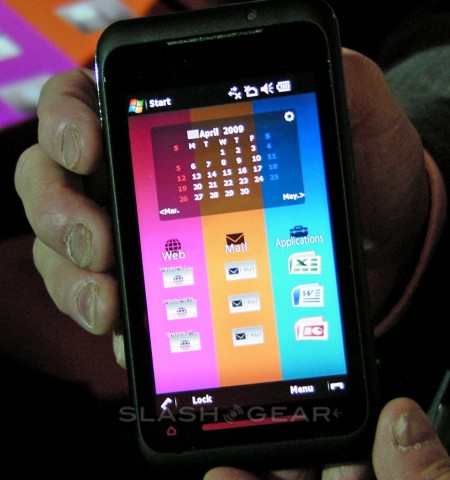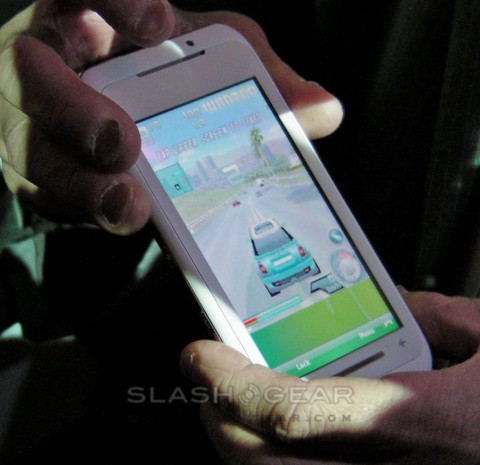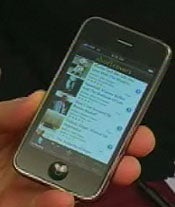Google is officially denying widespread Internet rumors that its Google Earth software located the mythical sunken city of Atlantis off the coast of Africa. Either that, or Google is totally trying to hide something. Since I always appreciate a nice juicy conspiracy theory, I'm going to go with the latter. Is this Atlantis? Apparently not, according to those meanies at Google. From what it sounds like, a British aeronautical engineer was playing around with the new Google Earth 5.0, which includes undersea data, and noticed something funny off the coast of Africa, about 600 miles west of the Canary Islands, that resembled a pattern of a street grid.According to the United Kingdom's Press Association, the pattern of streets equated to an area the size of Wales. In case you've had more important things to read about for the past few thousand years, Atlantis was a legendary island cityfirst mentioned by Plato, allegedly a hard-core naval power located somewhere near North Africa that disappeared when it sank into the ocean. Guess global warming was a problem back then, too. Anyway, most people think that Plato made it up, kind of like how those guys in Georgia made up the story about shooting Bigfoot, but others just won't stop believin'. So this guy is trawling the ocean floor with Google Earth--ah, if only we had that kind of free time on our hands--and was quick to announce his discovery. It looks like The Telegraph reported the story first, adding that the exact coordinates are 31 15'15.53N, 24 15'30.53W. You can find this imagery on wikimapia right now.. http://wikimapia.org/#lat=31.2691609&lon=-24.1644287&z=8&l=0&m=a&v=2
Sunday, February 22, 2009
Google Earth finds Atlantis
Thursday, February 19, 2009
Common barriers to personal happiness with solutions
Why You’re Not Happy
WebMD Feature
Happiness Barrier No. 1: Complexity
Happiness Barrier No. 2: A Breakneck Pace
Happiness Barrier No. 3: Negativity
Happiness Barrier No. 4: Despair
Happiness Barrier No. 5: Suppressing sadness
Happiness Barrier No. 6: Navel-gazing
Tuesday, February 17, 2009
Universal cell phone chargers coming soon
After I've spent years scrounging through drawers looking for the right charger and kicking myself every time I forgot my charger while traveling, the mobile industry has finally decided to make one device that can juice up any cell phone.

The Micro-USB connector used on this Motorola cell phone charger will soon be the standard for all chargers.
On Tuesday, the GSMA trade association announced at its 2009 Mobile World Congress here that it has brokered a deal with the world's leading handset makers to come up with a standard for charging cell phones.
All the major handset makers, including, LG, Motorola, Nokia, Samsung, and Sony Ericsson, have agreed to use the Micro-USB technology as the common universal charging interface, Rob Conway, GSMA CEO, said during the opening keynote speech Tuesday. By 2012, the GSMA promises, most cell phones will use the same kind of connector to charge their batteries.
Seventeen mobile operators, including Vodafone, Orange, and Telofonic, announced they are committed to implementing the standard for the universal mobile phone charger.
The GSMA said that going to this single standard will not only make life easier for the more than 3 billion mobile phone users in the world today, but it will also help the environment.
Conway said that the GSMA will push cell phone manufacturers to develop chargers that consume about 50 percent less power. The organization also believes that eliminating the need for people to replace lost chargers will significantly reduce greenhouse gases emitted in the manufacturing and transporting of these extra chargers. It will also mean less waste in landfills because people won't simply throw away chargers when they stop using their old phones.
All in all, it's huge win for the planet and for me--the consumer. It's such a no-brainer. It makes you wonder why no one thought of this sooner.
Can all that Twitters turn to gold
SAN FRANCISCO (AP) — Twitter Inc. has spawned a new way to communicate by limiting messages to 140 keystrokes. So here's a way to describe the Internet's latest craze within Twitter's space restrictions:
It's a potluck of pithy self-expression simmering with whimsy, narcissism, voyeurism, hucksterism, tedium and sometimes useful information.
One vital ingredient has been missing from the mix so far — revenue. That raises questions about whether the nearly 3-year-old service can make the leap from intriguing fad to sustainable business.
Twitter intends to start testing ways to make money this spring. And co-founder Evan Williams promises it won't drive away the more than 6 million people who have set up accounts on the unconventional communications network.
"We don't see any reason why this can't be a very large and profitable entity," said Williams, the San Francisco-based company's chief executive. "We have enough traffic on our Web site that we could put ads on there and maybe we could make enough to pay our bills, but that's not the most interesting thing we can do."
Williams, 36, won't say what he has in mind besides selling ads, but he and the handful of other people who own privately held Twitter seem confident the mystery strategy will pay off — even as a devastating recession destroys much-larger companies.
Just three months ago, Twitter rejected a $500 million takeover offer from an even bigger phenomenon, Facebook Inc., the owner of the world's largest online hangout.
Although shooing away Facebook was risky, Twitter still isn't under immense pressure to generate revenue. The 29-employee company has already raised $55 million, including a $35 million round recently completed with Benchmark Capital and Institutional Venture Partners.
Like Facebook, MySpace, YouTube and other communal Web sites that have become Internet sensations, Twitter gives people a stage where they can express themselves and connect with kindred spirits.
Twitter's twist is a more succinct approach, which has been likened to the 21st-century version of a telegraph.
Here's how Twitter works: After setting up a free account, people are encouraged to post frequent updates about what they are doing, seeing and feeling. The messages, known as "tweets," must be limited to 140 characters and can be sent from a mobile phone or a computer.
Although the updates are available for anyone to see, Twitter users usually set up their accounts to monitor the tweets of people they know or admire. These "followers" are automatically fed tweets from the people they are shadowing.
With more than 265,000 people tracking his messages, President Barack Obama has the most Twitter followers even though neither he nor his staff have tweeted since he moved into the White House last month.
Many other politicians and celebrities, such as basketball star Shaquille O'Neal (more than 72,000 followers) and former rap music sensation MC Hammer (more than 55,000) regularly share tweets.
Twitter also has become a way to peek at dramas unfolding behind closed doors.
When Yahoo Inc. laid off hundreds of workers last year, some of the casualties used Twitter to provide a blow-by-blow account of their final day at the office. Surgeons at Henry Ford Hospital in Detroit recently gave a rare glimpse inside an operating room by tweeting about the removal of a tumor from a patient's kidney.
Twitter also has proven to be a valuable source for breaking news, sometimes even beating long-established media outlets to the punch.
When US Airways Flight 1549 made an emergency landing on the Hudson River last month, a picture of the accident scene was quickly posted on Twitter by Janis Krums, a Sarasota, Fla., entrepreneur who was on one of the ferries that rescued passengers from the water. In November, Twitter provided harrowing, first-person accounts of the terrorist attacks in Mumbai that killed 164 people.
But Twitter mostly amplifies the humdrum of ordinary folks with apparently nothing better to do but share their monotony. There's plenty of posts along these lines: "Sitting at Corner Bakery in Frisco, Texas. Lunch was good." Or, "Another boring day at work, ugh." Or even, "I really do enjoy picking my nose." (A widely practiced pastime, based on recent tweets).
Finding out what's happening on Twitter is getting easier through a search engine called Summize that the company snapped up for an undisclosed amount last summer.
Both Williams and another Twitter founder, Biz Stone, suggested the search technology could emerge as their company's crown jewel. Its value lies in its ability to quickly sift through a steady stream of tweets to provide almost instantaneous insights about what's going on around the corner or around the world. Not even Google's Internet-leading search engine can match that now.
Stone relates how he used Twitter's search engine to ease his anxiety after he recently heard loud noises around his neighborhood. A quick search on Twitter informed him it was just a local celebration down the road.
The search engine will become even more valuable if people keep flocking to Twitter.
The site attracted 2.7 million U.S. visitors in December, a nearly eight-fold rise from the end of 2007, according to Nielsen Online. But Twitter's traffic increasingly is coming through mobile phones, making its usage more difficult to monitor. Nielsen estimates 666,000 U.S. users accessed Twitter on mobile devices in December.
The service is especially appealing to people between 18 and 34. About one in every five people with Internet access in that age group used Twitter or a similar service to update their status at least once, according to a survey of more than 2,200 adults in November and December by the Pew Internet & American Life Project. Meanwhile, usage of Twitter and rivals such as Jaiku, Pownce, FriendFeed and Plurk was seen in just 5 percent of respondents between 45 and 54. Only 2 percent of people older than 65 had tweeted, according to Pew.
This matters for Twitter's financial future because most younger people don't make a lot of money, which could make it more difficult for the company to appeal to advertisers.
Even so, corporate America is paying attention.
Several major companies, including JetBlue Airways Corp., have set up Twitter accounts to monitor what people are saying about their brands. The companies sometimes send out tweets offering to address a complaint.
All that chatter could yield a huge moneymaking opportunity if Twitter chooses to mine the data and sell the insights to marketers, said Marita Scarfi, chief operating officer for Organic Inc., an Internet advertising agency. "It could be rich vein for brand analysis," she said.
And though Twitter hasn't sold any ads yet, it is being used as a marketing tool. Computer maker Dell Inc., for instance, is offering exclusive discounts to its more than 18,000 followers on Twitter after holiday promotions broadcast on the service produced more than $1 million in sales.
Both Williams and Stone hinted the company is exploring ways to charge for expanded commercial access to Twitter, but emphasized that all personal accounts will remain free.
Online retailer Zappos.com is a big fan of Twitter, using it for promotions and customer feedback. But the Las Vegas-based company won't necessarily stay on board if Twitter starts imposing fees on businesses, said CEO Tony Hsieh.
"It would depend on what they're charging for," said Hsieh, who has attracted more than 58,000 followers since opening his Twitter account about a year ago. "We don't see it as a marketing channel, but as a relationship channel."
Comments like that feed the doubts about Twitter's future. Its prospects are clouded even further by the resistance that Facebook and MySpace have faced as they have tried to inject ads into forums where people primarily goof off or fraternize.
"It's the same kind of challenge for these sites," said Peter Daboll, who has studied consumer behavior on the Internet for years, including in his latest job as CEO of Bunchball Inc. "How do they build on their great audiences and keep them engaged, without alienating them with a bunch of crap?"
source
Monday, February 16, 2009
Galaxy has 'billions of Earths'
There could be one hundred billion Earth-like planets in our galaxy, a US conference has heard.

Dr Alan Boss of the Carnegie Institution of Science said many of these worlds could be inhabited by simple lifeforms.
He was speaking at the annual meeting of the American Association for the Advancement of Science in Chicago.
So far, telescopes have been able to detect just over 300 planets outside our Solar System.
Very few of these would be capable of supporting life, however. Most are gas giants like our Jupiter; and many orbit so close to their parent stars that any microbes would have to survive roasting temperatures.
But, based on the limited numbers of planets found so far, Dr Boss has estimated that each Sun-like star has on average one "Earth-like" planet.
This simple calculation means there would be huge numbers capable of supporting life.
"Not only are they probably habitable but they probably are also going to be inhabited," Dr Boss told BBC News. "But I think that most likely the nearby 'Earths' are going to be inhabited with things which are perhaps more common to what Earth was like three or four billion years ago." That means bacterial lifeforms.
Dr Boss estimates that Nasa's Kepler mission, due for launch in March, should begin finding some of these Earth-like planets within the next few years.
Recent work at Edinburgh University tried to quantify how many intelligent civilisations might be out there. The research suggested there could be thousands of them. sourceTuesday, February 10, 2009
Kindle's New Challenger Brings E-Books to iPhones
Amazon's new E Ink-powered Kindle 2 is all the rage right now, but a Canadian bookseller is confident it can give you the same experience on your smartphone, and without the hefty pricetag.
Shortcovers -- occasionally touted by its makers as "the Kindle Killer" -- is set to launch in the coming days as an app for the iPhone, the BlackBerry, and the Android operating system. So can it really live up to its king-sized claims? Read on and decide for yourself.
An Expanded E-Book Reader
Shortcovers is owned and operated by Indigo Books & Music, the largest book retailer in Canada. While smartphone-based e-book readers have been available in places like Apple's App Store for a while, it's Shortcovers' close ties to the publishing industry that set it apart from the pack. Because of the company's connections with major publishers, it's been able to secure the rights to brand new books that are often tough (if not impossible) to find on other services.
Like Kindle, Shortcovers will let you read the first chapter of any book free of charge. From there, the app offers you two options: You can either buy a chapter at a time, or opt to purchase the whole book. Single chapters are expected to cost around 99 cents a pop, while full books will range between $10 and $20, on average. If you decide you want to get a book physically shipped, you can do that, too.
Shortcovers says it'll have about 50,000 full books available upon launch, with another 200,000 individual chapters and excerpts in its library. Only a third of the titles will be public domain or copyright-expired works. The rest will be current commercial offerings.
Shortcovers plans to offer news and magazine articles, short stories, and blog posts in addition to the book content.
Kindle Comparisons
Compared to the Kindle, Shortcovers comes up a little short with the bells and whistles. You won't find a built-in dictionary, for example, nor will you be able to highlight text. There's no high-tech E Ink to make the pages look like real paper. The program's advantage, though, is its convenience: It's already right there in your pocket, so there's no need to tote around a second device. Fittingly, then, much of Shortcovers' publicity thus far has focused on the application's ability to let you read on-the-go -- a chapter here, a chapter there, wherever you happen to be.
As far as navigation, Shortcovers uses your phone's standard interface. With the iPhone, for example, you click onto your chapter of choice in a contents list, then scroll down the screen just like you do in other apps. Shortcovers allows you to adjust font size and choose from either standard or landscape mode on the phone. And, like the Kindle, it'll remember where you leave off in a book when you shut down, then bring you back to the same page when you return. You can go back and forth between reading on your phone and reading on the Shortcovers Web site with automatic synchronization as well.
The program offers some interesting social features, too, including a rating and sharing system, a tagging function, and a set of mashup tools in which you can build your own literary mixes. You'll even be able to upload your own writing and add it in.
The Long and Short of It
Shortcovers is scheduled to launch in the U.S. in late February, then in Canada shortly thereafter. Company exec Mike Serbinis talks more about the app and how it's come into existence in the following video interview with USA Today, conducted on the floor of last month's Consumer Electronics Show.
source
Tuesday, February 3, 2009
Touch Wars: Toshiba unveils iPhone killer
Toshiba only brought along two working TG01 prototypes to the London launch of the Windows Mobile 6.1 smartphone today, but SlashGear managed to get some in-use shots of the handset in action. The company is betting on consumers prioritising style, screen size and multimedia ability above all else, and while their claims to have created a “new category of product” can be dismissed as the usual marketing hyperbole, the Toshiba TG01 itself looks to be a very interesting device.

More photos and hands-on feedback on the Toshiba TG01 smartphone after the cut
Toshiba will come in for the usual criticism of Windows Mobile devices for using a resistive rather than capacitive touchscreen. Although there doesn’t appear to be a stylus silo in the handset itself, the company confirmed that a stylus would be present in the retail box. Happily, even though the TG01 doesn’t have Windows Mobile 6.5’s larger controls, the sheer scale of the 4.1-inch 800 x 480 display means that there’s plenty of room for fingers to jab. It remains to be seen how much the multi-pane rotating GUI covers up the Microsoft platform; on both demo devices we saw Toshiba reps accessing the standard Today screen and Start menu, though this could well be down to the pre-production status of the particular devices on show.
Minimal hardware controls are fine for most functions - the on-screen keyboard looks quite a bit like that of the iPhone, we noticed - but we’re not so sure about gaming. The 1GHz Snapdragon chipset should handle mobile games with aplomb, but the method of control demonstrated in the driving game Toshiba showed us seemed less than streamlined, requiring multiple taps on different parts of the screen. The photo in the gallery below, showing a rather contorted set of fingers all trying to touch the screen at once, is a good example of this.

On the positive side, while title developers - and Toshiba claim to be working with several to produce downloadable, internet-enabled games - will have to work to finesse the control interface, one thing they won’t need to worry about is performance. The video and gaming running on the demo TG01 handsets were both smooth, slick and high-resolution, even in the less than ideal lighting environment; we’d love to know if Toshiba plan a TV-out cable, as we’ve a feeling the TG01 would do a decent job hooked up to a full-size screen as a portable media player. Out of the box it supports DivX files, and of course thanks to full Flash support you can play online video too.
In the hand, the TG01 is surprisingly lightweight and alluringly thin. At just 9.9mm it’s significantly slimmer than the iPhone 3G (at 12.3mm) and the Touch HD (at 12mm), despite having a larger display than both rivals. The casing is finished in soft-touch plastic, with a chromed strip running around the edges, and aside from a few hardware buttons - camera (controlling the 3.2-megapixel shooter that seems to lack a flash of any sort), volume and power being two obvious ones - and the touch-sensitive “home”, “back” and scroll-strip along the base of the display, and the microUSB port lurking under a hatch, it’s generally a clean design. Make no mistake, this is a very pocket-friendly handset. source
IBM 20-Petaflop Supercomputer
IBM on Tuesday said the U.S. government has hired it to build a supercomputer 20 times more powerful than the world's fastest computer today. 
Called Sequoia, the massive system is expected to deliver 20 petaflops of computing power to the National Nuclear Security Administration, part of the Department of Energy. Sequoia will be used to simulate testing of the U.S. nuclear weapons stockpile.
IBM also will build a 500-teraflop computer called Dawn, which will provide the application foundation for computing on Sequoia.
A petaflop stands for a quadrillion floating-point operations per second, and a teraflop is a trillion calculations a second. To put Sequoia's computing power in perspective, what it can do in one hour would take all 6.7 billion people on Earth with hand calculators 320 years, if they worked together on the calculation for 24 hours per day, 365 days a year, according to IBM.
For example, Sequoia would provide 40 times more power than today's technology for monitoring and forecasting weather and a 50x improvement in scientists' ability to predict earthquakes and map out evacuation routes.
Sequoia will be built at the Lawrence Livermore National Laboratory and also will be used by the Los Alamos and Sandia national labs. The system will comprise 96 refrigerator-size racks with a combined 1.6 PB of memory, 98,304 compute notes, and 1.6 million IBM Power processor cores. The system, which will cover 3,422 square feet, will be built on IBM's future BlueGene supercomputer hardware and software technology.
"The longstanding partnership of NNSA, Lawrence Livermore National Laboratory, and IBM is ushering in an era of multipetaflop/s computing," NNSA Administrator Thomas D'Agostino said in a statement.
Indeed, IBM's Roadrunner was one of only two supercomputers to break the 1-petaflop barrier to hold on to its ranking as the world's fastest computer in the latest Top500 list released in November. Roadrunner reached a speed of 1.105 petaflops, while Cray's Jaguar reached 1.059 petaflops to take the second-place slot.
Sequoia is expected to be more powerful than the combined performance of all the systems on the Top500 list, according to IBM.
Monday, February 2, 2009
Nikon Unveils Eight New Coolpix Cameras
Nikon broke its awkward CES silence with eight new Coolpix announcements today, ranging from feature-heavy pocket cameras to sub-$200 bargains to an advanced model with 24X optical zoom. All the new additions to the Coolpix line will hit stores in March and April of this year. The $400 Nikon Coolpix P90, the megazoom model, offers a 24mm to 624mm, 24X optical zoom Nikkor lens and will hit stores in April. Nikon says that the Coolpix D90 features the same Nikkor ED glass found in the company's digital SLR cameras. To keep its megazoom shots blur-free, the P90 provides four-way image stabilization: optical CCD shift, detection and exposure optimization for moving subjects, high ISO capabilities, and a best-shot selector that takes up to 10 images in rapid-fire succession and keeps the sharpest image of the bunch. The P90 also offers full manual controls for shutter and exposure, an in-camera Quick Retouch editing feature, and a high-speed (15 frames per second) shooting mode with preshutter recording capabilities similar to those of the Casio Exilim EX-F1. Manual ISO settings reach up to 6400, and the P90's 3-inch LCD tilts forward and back. Also flexing some megazoom chops is the Coolpix L100, a 10-megapixel model with a 15X zoom lens that ranges from 28mm on the wide-angle end to 420mm on the telephoto end, with a minimum focus length of 1 centimeter in macro mode. Four-way image stabilization, a 3-inch LCD, and a 13-fps high-speed burst mode (with no preshutter buffer) are the other big draws of this $280 model, available in April. The L100 also comes with an Easy Auto mode, a Smart Portrait mode, and automatic scene selection. Rounding out the high-optical-zoom announcements is one of four new additions to Nikon's S series of Coolpix cameras, the Coolpix S630--though it skimps on the wide-angle end. With a 7X optical zoom ranging from 37mm to 260mm, the 12-megapixel S360 also offers four-way image stabilization; a 2.7-inch LCD; in-camera editing features; automatic scene selection; ISO equivalency up to 6400; a Smart Portrait setting that combines face recognition, smile trigger, blink detection, red-eye reduction; and an anodyzed stainless steel frame. Available in five colors (black, blue, red, purple, and silver), the S630 is available starting in March for $280. Though it's priced lower than the Coolpix S630, the $270 Coolpix S620 may be a smarter buy for one reason: a 28mm wide-angle lens on the low end of its 4X optical zoom lens. The 12-megapixel S620 also assembles most of the features found in the S630, including four-way image stabilization, automatic scene selection, in-camera editing features, and Smart Portrait mode. To these it adds motion-tracking autofocus and what Nikon claims is the "fastest start-up time in its class," at 0.7 second. The S620 will be available in black, purple, silver, pink, blue, and white starting in March. For touch-screen aficionados, the 10-megapixel Coolpix S230 boasts a 3-inch touch screen that you can operate with your fingers or with the included stylus. Other than the touch screen's fun-sounding 'paint function' mode, this model's specs are fairly standard: a 3X optical zoom (35mm to 105mm) lens, four-way image stabilization, Smart Portrait and automatic scene-selection modes, and in-camera editing apps. The Coolpix S230 will be available in March for around $230. Three of the new Coolpix announcements target budget buyers, with entry-level additions to the Coolpix S and L series. At $150, the ultracompact 10-megapixel S220 is just 18 millimeters thick. It has a 3X optical zoom (35mm to 105mm) lens and comes in five color choices: black, blue, plum, magenta, and green. It's slated for availability in March. The red, 10-megapixel Coolpix L20 will be available for $130 starting in March; it serves up a 3-inch LCD screen, automatic scene selection, in-camera image effects, and a 3.6X optical zoom (38mm to 136mm) lens. Nikon Coolpix P90

Nikon Coolpix L100

Nikon Coolpix S630

Nikon Coolpix S620

Nikon Coolpix S230

Sub-$200 Cameras: Nikon Coolpix S220, L19, and L20



